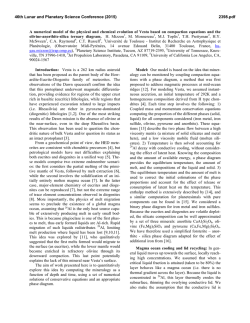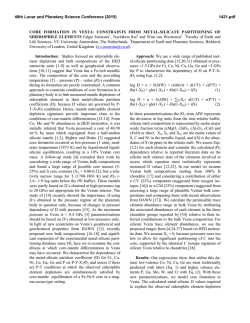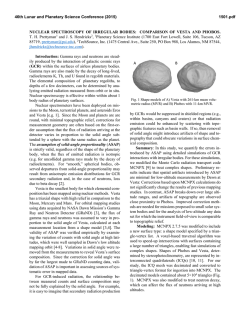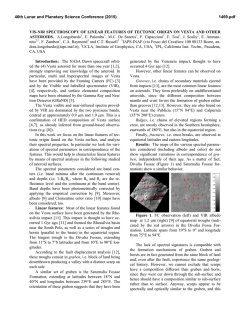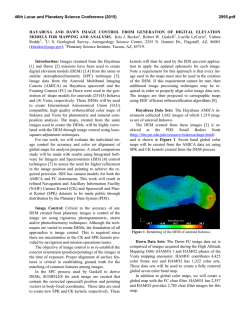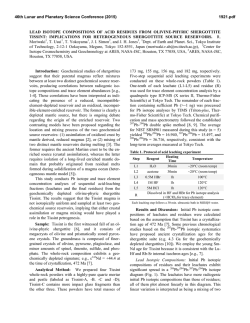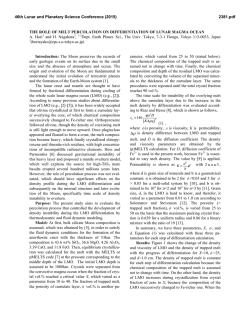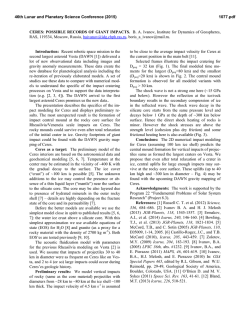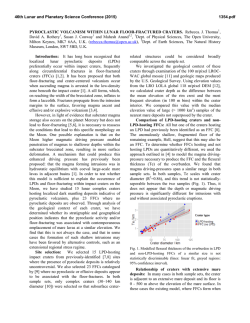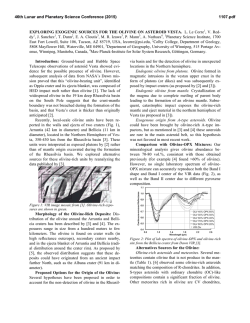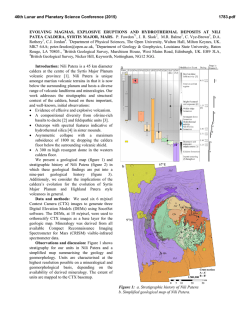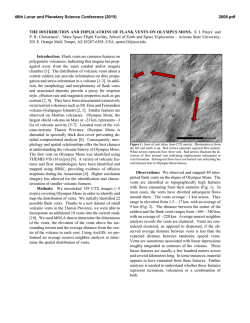
2107
46th Lunar and Planetary Science Conference (2015) 2107.pdf Modeling and comparing the crystallization processes and magmatic properties among a Kolbeinsy mid-ocean ridge basalt and HED meteorites from 4 Vesta.. A. L. Sandoval,1 L. S. Ortiz,2 1,2National University of Colombia, Department of Geosciences, Carrera 45 No 26-85, Edificio 224. Bogota D.C., Colombia ( [email protected], [email protected]) Introduction: Given their basaltic composition, meteorites from Vesta asteroid are comparable with (similar composition) igneous rocks found on Earth. Thus, the aim of the project is to compare, analyze and discuss the geochemistry, mineralogy, content of volatiles and trace elements, viscosity , glass transition temperature (Tg) and density of parental magmas of the basaltic rocks generated at mid-ocean ridges and rocks of basaltic nature from Vesta. Finally, the ability of these magmas to ascend through the oceanic crust on Earth was assessed. Metodology: To realize the study, a bibliographic research was developed regarding mineral and geochemical composition of meteorites from Vesta 4 (HED: Howardite, eucrite and Diogenite) which would give an approximation to the composition of parental magma that formed them [1]. Also, a mid-ocean ridge was selected and a bibliographic research was made in relation to the Kolbeinsy mid-ocean ridge, located in Iceland; one sample was selected to be melted and observe the process of magma crystallization [2]. Two articles were selected because they provide the information required in both environments to develop the study; these are cited at the end of work. The information collected is summarized in Figure 1. This table shows the percentage observed in volume of the chemical composition of a sample of basalt from Iceland [1] and the parental magma that formed asteroid Vesta [2]. Each composition was worked in PhasePlot; while the percentage of SiO2 of both are similar, the amount of MgO in the parental magma of Vesta is greater, and the concentrations of Al2O3, CaO and N2O are significantly lower; finally P2O3 and Fe2O3 are absent from the system. Thus, minerals such olivine, spinel and orthopyroxene begin to crystallize earlier from the parental magma of Vesta (which has a greater mafic composition). On the other hand, Iceland magma is a more differentiated magma, therefore this molten liquid begins to crystallize at lower values of pressure and temperature.Thus, it was proposed to search a point into the history of crystallization of the primitive magma of Vesta where the amount of magnesium decreased so that the liquid still present in the system had a similar composition to the Iceland magma, produced in the Kolbeinsy mid-ocean ridge. As a result, a similar liquid was found under specified values of pressure (585.7 MPa) and temperature (1265 ° C), where miner- als such as olivine, orthopyroxene and spinel have already crystallized in the system; this is the Vesta Residual Liquid. Figure 1: Compositional comparison among basaltic melt sample taken from Iceland, the Vesta residual liquid and the parental magma of Vesta. Software such as PhasePlot, the Silicate Melt Viscosity Calculator, a Spreadsheet to calculate the density and the FC-AFC-FCA and Mixing Modeler were used in order to assess the similarities and differences in the history of crystallization including physical and chemical properties at different values of pressure and temperature of the parental magmas that formed these rocks. Figure 2 illustrates the crystallization of the three molten liquids. All of them correspond to a tholeiitic series, ergo magmas are rich in Fe and Mg which crystallize basaltic rocks. Note that magnesium (Mg) tends to crystallize first; as the system cools, Fe concentration increases and the Mg leaves the magma to form minerals as olivine and spinel (Mg-rich minerals), later Fe starts to crystallize, its concentration decreases and the curve also decreases when alkali content increases. Differentiated magma of Vesta and the magma of Iceland show similar pattern; their compositions are similar and start to crystallize at similar temperatures and pressures. On the other hand, the Mg concentration is very high in the parental magma Vesta therefore will crystallize at higher temperatures compared to the other two liquids. Another objective of the work is to test the behavior of the Trace elements found in these samples based on their contents and their partition coefficients (D) using the software FC-AFC-FCA and Mixing Modeler. This will allow me to determine the role of trace elements in a process of fractional crystallization of certain minerals and thus compare the differences and similarities in 46th Lunar and Planetary Science Conference (2015) the history of crystallization of the liquids that formed these two samples. Figure 2: AFM diagram for three molten samples. Note that all of them follow tholeiitic series. For the density, the role of silica in density was studied in the three samples; density increases as SiO2 increases, ie, felsic magmas are less dense than basic magmas. Note that sample from Vesta has the highest density because its great amounts of MgO and FeO which has a great influence in the magma movement to the surface. The behavior of the Glass Transition Temperature (Tg) was tested and is mainly controlled by the magma composition, therefore the content of some compounds varies for the three samples; for instance, main components (SiO2, MgO) and volatiles such as H2O is changed in the system while the other compounds remain the same. In all three samples, the content of H2O has a major influence on the Tg; H2O increases when the value of Tg is greatly reduced making the melt less viscous. On the other hand, the magma rate of ascent was calculated using the previous data by the following formula: where v is the velocity of the magma, p and p` are the densities of the surrounding rocks and the melt (an environment of mid oceanic ridge on Earth was selected, where oceanic crust has an average density of 3170 kg/m^3), g is the gravitational constant, w is the width of the crack and n is the viscosity of the melt. Based on its original composition at 1100 ° C, the velocity was calculated in each sample, however, the speed value in the three cases was negative; it means that magmas descend instead of ascending because their densities are greater than the density of the crust. Therefore, the way to decrease the density of the three melts was searched (varying the composition, viscosity, volatiles content and temperature of the samples) in order to get magmas less dense than the oceanic crust. 2107.pdf Conclusions: After modeling the crystallization process of the sample obtained from Kolbeinsy midocean ridge and the residual liquid from the primitive magma of Vesta (which led the formation of HED meteorites), in both cases similar minerals crystallized such as augite, orthopyroxene, Ca-plagioclase, spinel and ilmenite. However, depending on the conditions of pressure and temperature the proportion and type of mineral can vary; slight differences in the initial proportions and the absence of certain compounds (such as the case of Fe2O3 for the residual magma of Vesta) influence the type of mineral that crystallize in the system and their proportion. Therefore, the primitive liquid of Vesta can crystallize by differentiation in basaltic rocks similar to those ones formed at mid-ocean ridges on Earth. The composition of the primitive magma of Vesta has similarities with mantle peridotite, this explains why the HED meteorites from Vesta are similar to the basaltic rocks found on Earth. Finally, the ascent of the three samples through the oceanic crust was modeled based on their densities and the density of the different layers that compose this type of crust. For instance, the Parental magma of Vesta could not rise through peridotite because its higher density, however, if the temperature or the volatile content dramatically increases, its density would decrease and would rise. The differentiated magma could rise through the peridotite and the lower part of the layer composed by Gabbro; the melt would not be capable of reaching the basaltic dikes because the dikes have much lower density. On the other hand, Iceland magma could reach the top of the gabbro layer because its lower density, but if the system is affected by decompression such as in a mid-oceanic ridge, high temperatures or enough dissolved volatiles, the melt would reach the surface. References: [1] Devey, C., Garbe-Schonberg, D., & Stoffers, P. (1994). Journal of Geophysical Research, 9077-9095. [2] Mandler, B., & Elkins, L. (2013). Meteoritics & Planet. Sci., , 2333-2349.
© Copyright 2025
